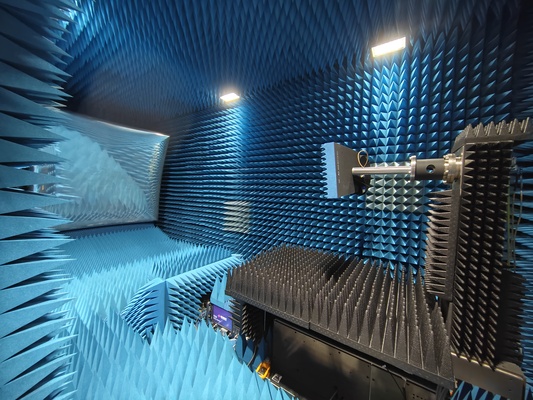
Sharp Corporation has built a state-of-the-art anechoic chamber that is capable of measuring the performance of flat panel antennas for LEO (Low Earth Orbit) and MEO (Medium Earth Orbit) satellites in its Makuhari office (Chiba City, Chiba Prefecture, Japan), which will be operational starting September 12, 2024. The anechoic chamber employs the CATR (Compact Antenna Test Range) method to measure the radio wave characteristics of long-distance communications (typically observed in satellite communication) over a short distance and can accommodate one of the largest antennas in Japan with an aperture of up to 80cm. The state-of-the-art facility is subsidized by the National Institute of Information and Communications Technology (i.e., NICT) (JPJ012368G50501).
Our state-of-the-art anechoic chamber using the CATR method ensures that the flat panel antennas designed for satellite communications work as expected in the real world to deliver unparalleled user experience. To design the anechoic chamber, the ceiling, walls, and floor are covered with high quality radio wave absorbing material to suppress undesired reflections of radio waves, and parabolic reflectors are used to conduct measurement over a short distance. In a typical anechoic chamber, a distance of more than 60m is generally required to measure the performance of an antenna with an 80cm aperture. However, using the CATR method in our state-of-the-art anechoic chamber, we can accurately measure antennas with an aperture of up to 80cm for a wide range of frequency (10-40GHz) over a short distance of only approx. 7m. This novel anechoic chamber will also help us conduct tests and measurements more efficiently, which in turn will significantly accelerate the development process and expedite the path to commercialization.
In addition to the Ku/Ka*3 bands used for satellite communications, this anechoic chamber also supports measurements in the upper mid-band i.e., FR3 (6-24GHz), which is considered as a potential band for 6G deployment around the world. The launch of this facility will enable testing and technical verification of various products such as next-generation smartphones.
Furthermore, we are happy to announce the "SHARP Local 5G Trial Field*4 " has been renamed to "SHARP NEXT GENERATION COMMUNICATION Trial Field”. In the near future, this trial field, including the state-of-the-art anechoic chamber, will become a collaborative workspace that would enable partner companies/universities/research labs/government organizations to use our state-of-the-art facility and equipment to design, test, analyze and create new solutions and products.
|
Location |
Start of Operation |
Chamber Size |
Supported Frequencies |
|
Sharp Makuhari Office (Chiba City, Chiba Pref., Japan) |
Sept., 12, 2024 |
Width approx. 7.0m x Depth approx. 3.2m x Height approx. 3.5m |
10GHz-60GHz |
■ Outstanding Features
1. The state-of-the-art anechoic chamber uses the CATR method to accurately measure antennas with an aperture of 80cm or less in a small form factor of just 7m in length.
2. The anechoic chamber is built in the Makuhari Office. This is also the same location where we have developed satellite communication antennas, to expedite the development and commercialization of 6G.
3. Measurements of next-generation smartphones and other devices in addition to satellite communication antennas can be conducted in the anechoic chamber over a wide frequency range, including the Ku/Ka band and the upper-mid band, which is a potential band for 6G deployment around the world.
*1 As of September 11, 2024; this state-of-the-art anechoic chamber is one of the largest in Japan excluding JAXA facilities. According to Sharp.
*2 LEO : Low Earth Orbit, MEO : Medium Earth Orbit
*3 Frequency bands allocated for satellite communications. Examples of frequencies used by non-geostationary satellite communication systems. Ka band: 17.8-18.6GHz/18.8-19.3GHz (Space to the Earth), 27.5-29.1GHz/29.5-30.0GHz (the Earth to Space) and Ku band: 10.7-12.7GHz (Space to the Earth), 14-14.5GHz (the Earth to Space). * Source of frequency bands (https://public-comment.e-gov.go.jp/pcm/download?seqNo=0000211013) (in Japanese only)
*4 Established in 2021 as a place for co-creation of new solutions using local 5G. (https://corporate.jp.sharp/news/210203-a.html)
■ Details of the state-of-the-art anechoic chamber
|
Measurement Method |
CATR (Compact Antenna Test Range) method |
|
Chamber Size |
Width approx. 7.0m x Depth approx. 3.2m x Height approx. 3.5m |
|
Frequency range |
10-60GHz (CATR compatible frequencies) 500MHz-100GHz (Anechoic Chamber compatible frequencies) |
|
Quiet Zone*5 |
10-40GHz : Φ80cm 40-60GHz : Φ60cm |
|
Shield Performance |
-50GHz : 80dB or more 50-100GHz : 60dB or more |
|
Positioner |
Load Capacity: 40kg Azimuth / Roll Axis: -180 to +180deg, 0.1deg resolution |
*5 Amplitude Variation : 1.2dB (Taper + Ripple), Phase Variation : +/-7deg (Taper), +/-5deg (Ripple)
The amount of variation in amplitude and phase measured within the quiet zone plane.
【 Contacts 】 NTN_B5G@sharp.co.jp


 Choose
Choose